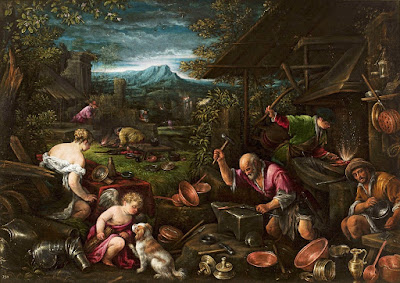 |
| Francesco Bassano the Younger St Jerome before 1592 oil on canvas private collection |
 |
| Francesco Bassano the Younger Virgin and Child in Glory with St John the Baptist and St Nicholas of Bari 1570 oil on canvas Chiesa di San Giacomo dall'Orio, Venice |
 |
| Francesco Bassano the Younger Preaching of St John the Baptist 1570 oil on canvas Chiesa di San Giacomo dall'Orio, Venice |
 |
| Francesco Bassano the Younger Battle Scene - Charles VIII receiving the crown of Napoli before 1592 oil on canvas Musée des Beaux-Arts de Lyon |
 |
| Francesco Bassano the Younger Forge of Vulcan before 1592 oil on canvas National Museum, Warsaw |
 |
| Francesco Bassano the Younger Forge of Vulcan ca. 1577 oil on canvas private collection |
 |
| Francesco Bassano the Younger Christ stripped of his Garments before 1592 oil on canvas Museo Civico, Cremona |
 |
| Francesco Bassano the Younger The Flagellation 1583 oil on canvas Pinacoteca del Castello Sforzesco, Milan |
 |
| Francesco Bassano the Younger Abraham leaving Haran before 1592 oil on canvas Rijksmuseum, Amsterdam |
 |
| Francesco Bassano the Younger The Good Samaritan ca. 1575 oil on canvas Kunsthistorisches Museum, Vienna |
 |
| Francesco Bassano the Younger Jacob and Rachel ca. 1567 oil on canvas Kunsthistorisches Museum, Vienna |
 |
| Francesco Bassano the Younger Adoration of the Magi ca. 1578 oil on canvas Palazzo Pretorio, Prato |
 |
| Francesco Bassano the Younger Presentation of Christ in the Temple before 1592 oil on canvas Alte Pinakothek, Munich |
 |
| Francesco Bassano the Younger Summer, with the Sacrifice of Isaac ca. 1585-90 oil on canvas Kunsthistorisches Museum, Vienna |
 |
| Francesco Bassano the Younger Peasant butchering a Pig before 1592 oil on canvas Musée Ingres, Montauban |
"The shop that helped Jacopo Bassano to multiply his efforts, in his later years on a scale like that of a minor industry, was staffed most importantly by his own sons. In order of age they were Francesco (named after his grandfather), born in 1549, who died a suicide in 1592, shortly after Jacopo's decease, Giovanni Battista (1553-1613), Leandro (1557-1622), and Gerolamo (1556-1621). Of the lot, Francesco was the only painter of distinct talent. He was formed in his father's mode of the 1560s and matured into Jacopo's less mannered, more veristic style of the seventies; he then began to work not only as a collaborator with Jacopo, signing pictures jointly with him, but independently as well. In 1579 Francesco moved to Venice, where his career included official state commissions for the Palazzo Ducale as well as pictures in his father's vein. He particularly pressed a development of chiaroscuro that Jacopo had made earlier, the painting of nocturnes – a much appreciated taste also elsewhere in North Italian painting of the time. He exaggerated Jacopo's late manner in general towards more obvious effects and towards a rougher touch, and the verism that had been a tendency in his father's style at the time Francesco matured grew to be a still more positive inclination in the son."
– S.J. Freedberg, Painting in Italy 1500-1600 in the Pelican History of Art series (1970)